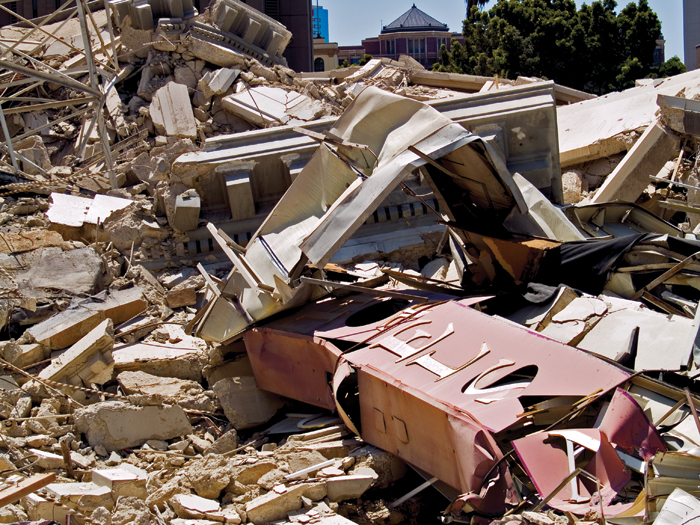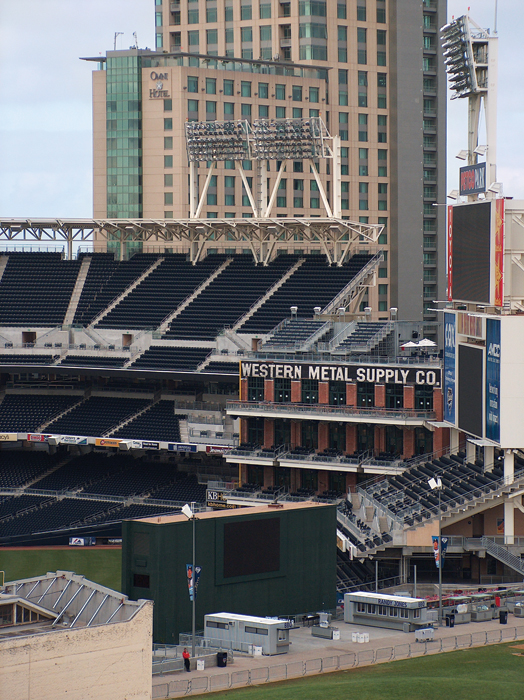|
Historic Preservation & Environmental Conservation
By Jaye MacAskill
More than two decades of growing environmental awareness have convinced many people to recycle their cans, bottles and newspapers, and to try to use up less energy and natural resources overall. "Reduce! Reuse! Recycle!" goes the popular mantra. So then, why don't environmentalists get more upset when all their efforts to conserve are negated with the demolition of just one older or historic building? It only seems natural that anyone desiring to protect and preserve the environment for future generations would also consider themselves to be historic preservationists. "Historic preservation is the ultimate recycling strategy," says esteemed economist Donovan D. Rypkema.

The Hotel San Diego demolition debris waiting to be trucked to the landfill. It was built with reinforced concrete and had stood the test of time with no indication that it would not have lasted another 87 years. Photo by Sandé Lollis
There are many proven benefits associated with historic preservation including retaining a community's unique sense of place and stimulating the local economy. A compelling list of other environmental and economic advantages also supports the preservation and reuse of existing building stock. Real estate is an asset that typically has a long physical and economic life, and historic rehabilitation can be both energy efficient and life-cycle cost effective. Although most historic buildings do not require complete transformations in order to retain their usefulness, rehabilitation is always a cost-competitive alternative compared to starting anew. While many ill-informed developers and others might argue incorrectly that it is somehow cheaper to rebuild rather than rehabilitate and restore, in actuality there is a huge monetary cost as well as environmental cost tied to this practice.
In this current debate with the building industry, one of the most important phrases is "embodied energy," meaning that when a building is torn down, we lose not only the structure but also the total amount of human and mechanical energy that originally went into its construction. The loss of embodied energy and irreplaceable historic fabric aside, however, tear-downs release toxins and other pollutants directly into the air, water and soil, and they produce massive amounts of debris that must go into dirty and unsightly landfills. According to The Economics of Historic Preservation: A Community Leader's Guide, by Donovan Rypkema, builders in the U.S. generate approximately 31.5 million tons of construction waste per year, a number that represents almost 24% of the total municipal solid waste stream. But in addition to taxpayers paying to maintain these landfills, they also pay a greater environmental cost down the line; the demolition and the hauling away of waste materials require the use of non-renewable energy and exact a toll on our long-term efforts to reverse the effects of global warming. So, in addition to tear-downs creating their own set of acute environmental problems for today and for the future, economically, they have far-reaching negative effects as well.
Combating suburban sprawl by encouraging urban density is another important consideration when evaluating the environmental benefits of historic preservation. Sprawl takes a major toll on the environment by consuming thousands of acres of forests, farms and wetlands for new residential and commercial use. This requires the construction of new additional infrastructure such as schools, other public buildings, playgrounds and parks, streets and sewer lines. However, rehabilitating and reusing abandoned or underutilized properties reduces the need to expand into undeveloped land. The amount of energy and materials required to produce new infrastructure is also significantly reduced in areas where it already exists.

The reuse of the Western Metal Supply Company building is just one example of literally tons of building materials and resources that were saved from the landfill, and one which received acclaim from around the world. Photo by Sandé Lollis |
Newer is not better strictly by virtue of the fact that it is new. In reality, having been made of higher quality materials and built of sturdier construction, older and historic buildings are often superior to their contemporary counterparts. Newer buildings tend to have a life expectancy of only 30-40 years, whereas older buildings, especially those with load-bearing walls, were literally "made to last." In addition to their durability, many buildings constructed prior to 1970 are often more energy efficient and have lower utility costs. In many cases, thick solid walls provide greater insulation and require less energy for heating and cooling. Even though energy conservation was not the original intention, the planning details often found in historic buildings frequently capitalize on natural light and ventilation to regulate the interior climate through site orientation and layout. Historically, components such as windows and doors were generally not intentionally designed to be energy efficient either, but they can be retrofitted to meet current standards at less immediate and long-term costs than utilizing contemporary replacements. "Furthermore," adds Rypkema, "original building materials retain their usefulness, and historic rehabilitation itself uses less energy, raw materials and natural resources." If environmentalists are to be truly environmentally minded, therefore, they should start looking at historic buildings as an important part of the recycling chain.
The Sustainability Initiative from the National Trust is guided by four core principles of sustainable stewardship and respect for our existing built environment.
Reuse of our existing buildings reduces the amount of demolition and construction waste deposited in landfills, lessens the unnecessary demand for new energy and other natural resources needed to construct a new building, and conserves the energy originally expended to create the structures.
Reinvestment in older and historic communities also has numerous environmental benefits. Older and historic communities tend to be centrally located, dense, walkable, and are often mass-transit accessible, qualities promoted by Smart Growth advocates.
Reinvestment in these communities also preserves the energy expended in creating the existing infrastructure, such as roads, water systems and sewer lines.
Retrofits of historic buildings can and should be undertaken to extend building life and better capture the energy savings available through newer technologies.
Sustainability by the Numbers
The Costs of Construction & Demolition
- The average home size in the United States has increased 105% between 1950 and 1999.
- The United States is responsible for 22% of the world's greenhouse gas emissions, though we have only 5% of the world's population. According to the Pew Center on Climate Change, the operation of buildings accounts for 43% of carbon emissions in the United States. The environmental impact of buildings is even more significant when we take into consideration the greenhouse gas emissions associated with manufacturing building materials and products.
- In terms of waste, construction of an average 2,000-square-foot home generates 3,000 pounds of wood, 2,000 pounds of drywall and 600 pounds of cardboard. Moreover, the construction of an average single-family home generates four pounds of waste per square foot. On average, only about 20%-30% of that waste is recycled or reused.
- It takes a lot of energy to construct a building - for example, building a 50,000 square foot commercial building requires the same amount of energy needed to drive a car 20,000 miles a year for 730 years.
- We are much too inclined to think of our buildings as disposable rather than a renewable resource. A 2004 report from the Brookings Institution projects that by 2030, we will have demolished and replaced 82 billion square feet of our current building stock. Since it is estimated that there are about 300 billion square feet of space in the United States today, that means we anticipate demolishing nearly 1/3 of our building stock in the next 20-25 years.
- It will take as much energy to demolish and reconstruct 82 billion square feet of space (as predicted by the Brookings study) as it would to power the entire state of California - the 10th largest economy in the world with a population of about 36 million people - for 10 years.
- If we were to rehab even 10% of this 82 billion square feet, we would save enough energy to power the state of New York for well over a year.
- Construction debris accounts for 25% of the waste in the municipal waste stream each year. Demolishing 82 billion square feet of space will create enough debris to fill 2,500 NFL stadiums.
Energy Efficiency of Historic & Older Buildings
It is often assumed that older and historic buildings are "energy hogs" and that it is more environmentally friendly to demolish these buildings and construct new energy efficient buildings. However, recent work indicates otherwise.
- The average embodied energy in existing buildings is five to 15 gallons of gasoline per square foot. The average embodied energy in a 250,000 square-foot office building is 3.75 million gallons of gasoline.
- Recent calculations indicate that it takes about 65 years for an energy efficient new building to save the amount of energy lost in demolishing an existing building.
- Far from being "energy hogs," some historic buildings are as energy efficient - or more so - than buildings constructed in later decades. Data from the U.S. Energy Information Agency finds that buildings constructed before 1920 are actually more energy-efficient than those built at any time afterwards - except for those built after 2000.
- In 1999, the General Services Administration examined its building inventory and found that utility costs for historic buildings were 27% less than for more modern buildings.
Reprinted with permission from the National Trust for Historic Preservation, https://www.preservationnation.org/issues/sustainability/additional-resources/sustainability-numbers.html |
Currently Vice President of SOHO, Jaye Furlonger received a Masters degree in Public History from the University of San Diego in 2005 after working in the museum field in New York City for several years. Having grown up on beautiful Vancouver Island (Canada), Ms. Furlonger feels equally as strong about preserving the natural environment as she does about saving historic structures.
|
MORE FROM THIS ISSUE
From the Editor
2009 People In Preservation Award Winners
Historic Preservation & Environmental Conservation
The Green Game
Making your historic home more energy efficient
Your home's landscape is green in more ways than one
San Diego Trust & Savings Bank Building
Black Gold in San Diego
2009 Most Endangered List of Historic Resources
Tragedy Unfolds
Preservation Community
Reflections
Recognition
The Whaley House Porch Returns
Museum News: Marston House
Borrego Springs Modern lll
Borrego's future lies in its past
Adobe University
An Enchanted Evening at PIP
Looking for historic homes, gardens or commercial sites
Help Us
Lost San Diego
Strength in Numbers
Advertisements
DOWNLOAD full magazine as pdf (9.7mb)
|





